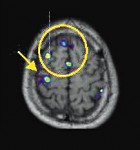High-Res PET Scans Said Better Than fMRI
 South Korean neuroscientists experimenting with high-resolution positron emission tomography (PET) brain scans claim the technique offers more accurate results than fMRI techniques. Cho Zang-hee, the director of Gachon University of Medicine and Science’s Neuroscience Research Institute in Incheon, studied which brain areas were activated during simple finger motions by subjects and called past fMRI results “wrong”.
South Korean neuroscientists experimenting with high-resolution positron emission tomography (PET) brain scans claim the technique offers more accurate results than fMRI techniques. Cho Zang-hee, the director of Gachon University of Medicine and Science’s Neuroscience Research Institute in Incheon, studied which brain areas were activated during simple finger motions by subjects and called past fMRI results “wrong”.
fMRI devices have been the favorite for cognitive science research since they can scan spots where blood gathers when the brain is active. PET shows the actual spot where nutrients from the blood are consumed, but due to its lower resolution, it has not been used for research.
Cho said many researchers have suspected that fMRI shows up inactive parts of the brain as well as active sections. His team used a special high-resolution PET (HRRT) to prove that the suspicion was true. There are only six HRRTs in the world.
Cho added fMRI shows all parts of the brain blood is supplied to, while PET shows the exact section where nutrients are consumed.
The quote is from Korean Scientists Pinpoint Seat of Action in the Brain. The limited availability of these high-res PET scanners means that use for neuromarketing studies will be difficult at the present time. Still, technology improvements tend to migrate toward lower cost and wider availability, and we can expect to see more of these units in the future. We just wrote about high-res fMRI brain scansearlier this week – it looks like Ray Kurzweil’s predictions about rapidly improving resolution of brain imaging techniques in The Singularity is Near are on track so far.
